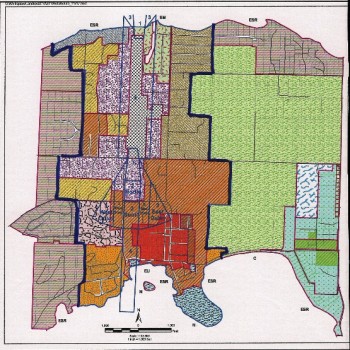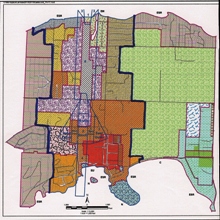— by Margie Doyle —
[metaslider id=47685]
Gretchen Krampf,Thrive Orcas Island community organizer and co-founder of Leadership San Juan Islands, said at the opening of the 50-50 Vision for Eastsound gathering last night (Wednesday, Oct. 26), “It’s the beginning of a conversation, not a plan.”
Krampf referred to the initiative “Vision for Eastsound,” organized by Jim Jonassen, himself inspired by Bob Maynard’s perception that without a vision, future development of Eastsound will be sure to disappoint. The document is available online here: Vision4Eastsound
Krampf recalled a meeting the she and Jared Lovejoy had with Jonassen and Maynard last month about the need to engage “the Millennials,” the under-50 folks who will influence such a vision, and be impacted by the results. “Let’s set up an event and see who shows up,” Gretchen said simply.
And show up they did, probably 100 folks who self-sorted into under-50 and over-50 and then mixed it up at 11 tables to discuss their ideas, following a presentation by Jonassen of the long-term community project.
County Councilman Rick Hughes commented that it was the largest turnout he’d seen for a meeting, and represented the greatest diversity of ages.
Krampf asked for a show of hands as to how people had heard of the meeting: Facebook and “word of mouth” were far and away the chosen method of communication of the room. She announced a new website Eastsound.Vision.com to forward the discussion, and encouraged people to sign up their emails to be notified when the site is “live,” and to join the Eastsound Vision group on Facebook.

Eastsound Urban Growth Area (UGA) with the Eastsound Subarea boundaries in dark blue.. The “Vision for Eastsound” process focuses on the urban core, with a quarter-mile radius from the Village Green.
Jonassen gave an overview of the “Vision for Eastsound,” spear-headed by the Eastsound Planning Review Committee (EPRC) the county advisory committee for the development of Eastsound. Last year, the group presented an update to the “Eastsound Subarea Plan” and this year, it expects to work with the County Council in revising the County Comprehensive Plan. Following a Town Hall meeting in March 2015 (orcasissues.com/public-informs-advisors-and-officials) Jonassen and Maynard rounded up a group of stakeholders for suggestions on what a Vision for Eastsound may look like.
That document was published this past June and is available through the public library at orcaslibrary.org/docs/vision4eastsound.pdf. Hard copies are also available at the library.
Jonassen told the 50-50 group, “The Vision for Eastsound is not intended to be a sales job on any idea; and yes some ideas are tongue-in-cheek and flat-out stupid, but they were fun to do.” He quoted from the County Comprehensive Plan, “Visions allow people to dream and look into the future, to imagine what our community can become at its best.”
He outlined the elements and related issues that such a plan for the future could incorporate:
• Vision itself
• Character – visual and experiential , walkability/permeability. Current standards don’t apply to single family residences; streetscape (Prune Alley i.e.) are we happy with the standard and do we want to unify it in the village?
• Infrastructure – water, sewer, stormwater. Currently we are treating only about ¼ of stormwater runoff in village; there is “a high probablility for grant funding” for stormwater projects;
• Greenscape – constructed wetlands such as behind the Stage on the Green; Crescent Beach road by-pass and restoration;
• Ethos, amenities, opportunity, public spac : Fern Street Park offers eight alternatives from parking lot “which we can’t do,” street alternatives, public square, transit stop, park.
• Waterfront – titles include covenants that should open up viewpoints in buildings that are currently closed off
Jonassen spoke of the recent changes at the Fern Street Park as an example of “individual initiative”to add amenities to Eastsound. Another example of group effort is the Stage on the Village Green, a “combination of public and private support.”
He brought up concepts such as density in Eastsound vs. ‘”suburbanization” of the rural parts of the island; building heights; housing; cluster/underground/offsite parking options; traffic alternatives and connecting streets, walkability, preservation
After determining that about half the meeting’s attendees have read the “Vision for Eastsound,” but only a handful had completed the survey, (available at ) Johanssen reported on the key points from early survey returns:
- Increase public restrooms
- Walking and biking trails
- Buck Park-Funhouse-Orcas Center-Village trail
- Restored Crescent Beach area
- Enhance and encourage path to the Village core
- New constructed wetlands
- Street facing porches, balconies
- Retailers/ institutions allowed use of private parking
Johanssen encouraged those at the meeting to complete the survey and attend workshops resulting from the recent meetings. He said, “They will be intensive; and tough for those working every day and raising families.” He said he expected all the workshops to happen in a single week, in a series of sessions, to approach consensus and plan for implementation.
“Whatever comes of this goes to the EPRC. They basically decide what to go forward with to recommend to the County Council.
“We want to solicit the under-50s to engage as member on the EPRC — and there is currently a vacancy; they are the decision-making group that represents us.” The Eastsound Planning Review Committee’s next regular meeting is Thursday, Nov. 3 from 3 to 5 p.m. in the Eastsound Fire Hall.
Jonassen reminded the groups before they began their table discussions, “A vision is ethereal; and different to different people. The vision statement is your philosophy, such as ‘consciously enhanced as a nurturing hometown within a beautiful natural environment, provider of essential services for the island community while supporting low impact employment,'” he began.
Gretchen Krampf then invited the tables to focus their discussions to “What is crucial to you to include in a vision for Eastsound?” Following about 30 minutes of discussion, the tables then reported out to the group their most important conclusions.
(To see the results of the 50-50 discussions, read the following article “Enlightened Proposals Come Forward from Millenials”)
**If you are reading theOrcasonian for free, thank your fellow islanders. If you would like to support theOrcasonian CLICK HERE to set your modestly-priced, voluntary subscription. Otherwise, no worries; we’re happy to share with you.**









Margie…you wrote: “After determining that about half the meeting’s attendees have read the “Vision for Eastsound,” but only a handful had completed the survey”. A digital version of the survey which can be completed online is now available on the Library website “Community Documents” page…the URL is:
https://docs.google.com/forms/d/e/1FAIpQLSfCodpExlbETbrDmVK3rCMUKtz4w4ccGtIBdEylQZiC_tHK0A/formResponse
What was surprising to me at the 50-50 meeting is that nobody mentioned water as THE issue that needs to be informing all sustainable vision; along with remaining standing forests that act as windbreak and water filtering systems – especially forested wetlands. Hopefully, their restoration will be in the final vision.
Learner Limbach brought up the sewer issue, which needs addressing. Many brought up the piped stormwater issue as not being the most sustainable or land/forest friendly – so it surprises me to see that people would opt for forests torn down and replaced with “emergent” constructed wetlands( also called “pocket wetlands,” which, the “inventor” of them admits, do not work and are not successful. The inventor of them now thinks that mixed forested wetlands are what work.) Most did not want a solely tourist economy either; they wanted cottage industry back and a year round economy that catered to locals.